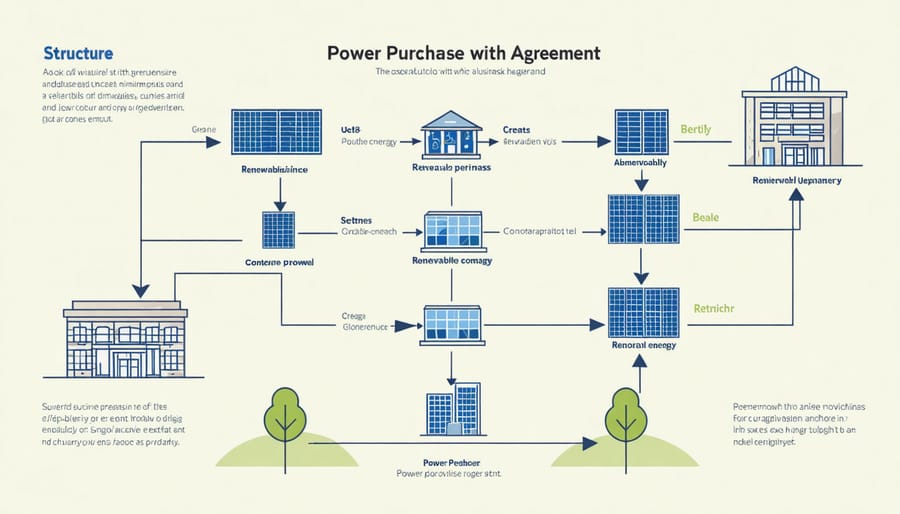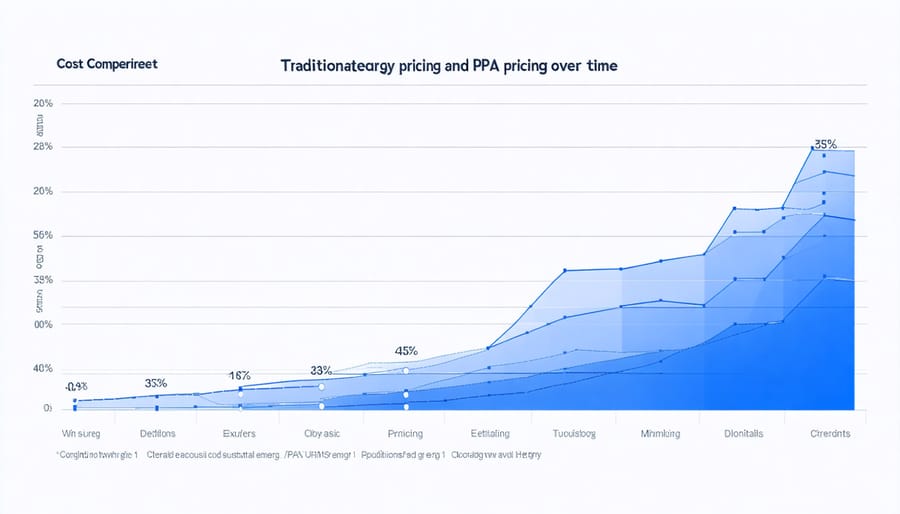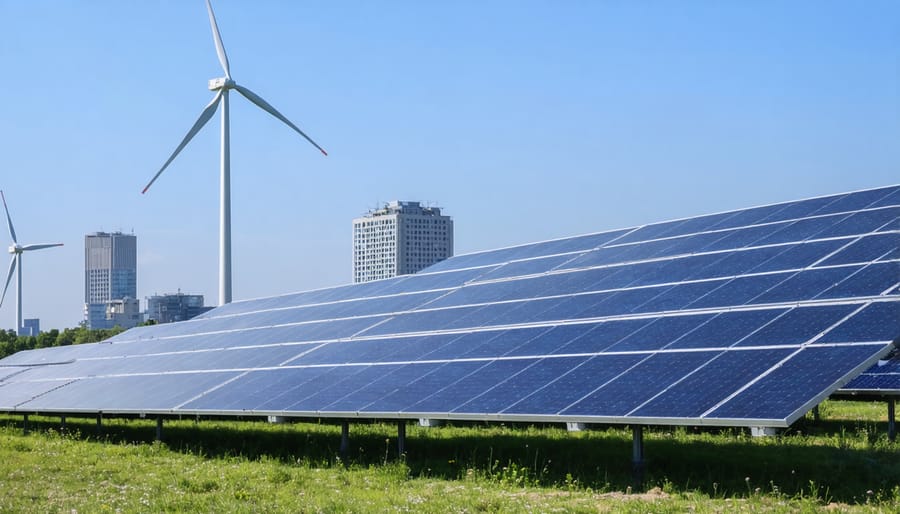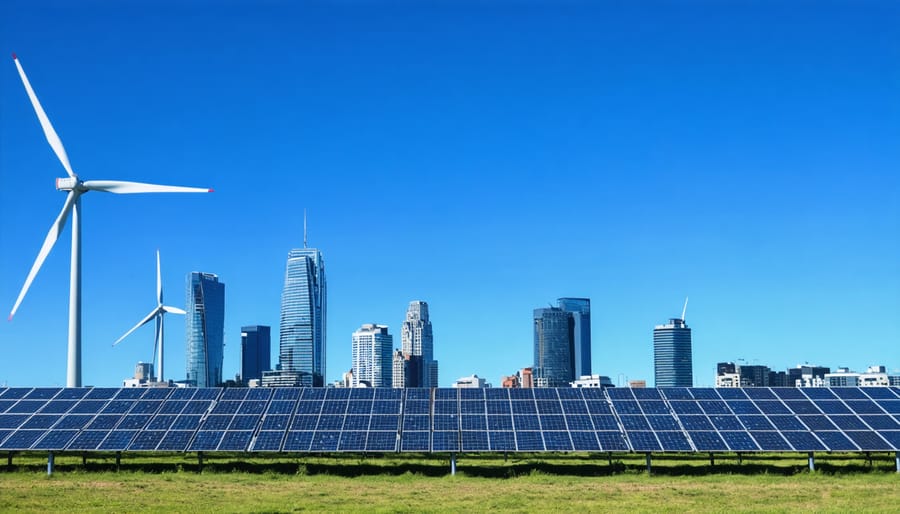Power Purchase Agreements (PPAs) are revolutionizing how businesses access renewable energy, offering a direct path to sustainability while protecting against volatile energy costs. These long-term contracts between energy generators and corporate buyers represent a transformative shift in Australia’s energy landscape, where organizations can now secure clean electricity at predictable prices without owning solar panels or wind turbines themselves.
Think of a PPA as a strategic partnership: renewable energy providers commit to delivering clean power, while businesses guarantee to purchase that electricity at an agreed price over 10-20 years. This arrangement has already enabled major Australian companies like Woolworths and Telstra to dramatically reduce their carbon footprint while maintaining budget certainty.
For forward-thinking organizations, PPAs offer a powerful solution to three critical challenges: meeting sustainability goals, managing energy costs, and supporting the growth of renewable energy infrastructure. As Australia accelerates its transition to clean energy, PPAs have emerged as a vital tool for businesses ready to lead the charge toward a more sustainable future.
This groundbreaking approach to energy procurement isn’t just changing how companies buy power – it’s fundamentally reshaping Australia’s energy market and setting new standards for corporate environmental leadership.
What is a Corporate Power Purchase Agreement?

Physical vs. Virtual PPAs
In the renewable energy market, two distinct types of Power Purchase Agreements have emerged to meet diverse business needs. Physical PPAs, also known as traditional PPAs, involve the direct delivery of electricity from a renewable energy facility to the buyer. These agreements work particularly well for organisations with significant energy consumption and those wanting a tangible connection to their power source.
Virtual PPAs, on the other hand, are financial instruments that don’t require physical electricity delivery. These contracts operate through smart contract technology and financial settlements, making them increasingly popular among Australian businesses seeking renewable energy solutions without geographical constraints.
The choice between physical and virtual PPAs often depends on several factors. Physical PPAs offer the advantage of direct energy supply and typically provide more predictable pricing structures. They’re particularly suitable for businesses located near renewable energy facilities or those with the capability to receive power directly from generators.
Virtual PPAs provide greater flexibility and accessibility, especially for businesses with multiple locations or those unable to receive direct power from renewable sources. They’re ideal for organisations wanting to support renewable energy development while maintaining their existing power arrangements.
Both types help organisations meet their sustainability goals and manage energy costs effectively. For example, many Australian retailers have embraced virtual PPAs to achieve their renewable energy targets across widespread operations, while manufacturing facilities often prefer physical PPAs for their consistent power needs and direct supply benefits.
Key Components of a PPA
A well-structured Power Purchase Agreement contains several vital components that work together to create a robust and mutually beneficial arrangement. At its core, every PPA defines the agreed electricity price and volume, typically expressed in dollars per megawatt-hour (MWh) and the total amount of electricity to be supplied annually.
The agreement duration is another crucial element, with most PPAs ranging from 10 to 20 years in Australia. This long-term commitment provides certainty for both parties and helps secure project financing for renewable energy developments.
Performance guarantees and obligations form a significant portion of the agreement, outlining the seller’s commitment to deliver specified amounts of electricity and the buyer’s obligation to purchase it. These terms often include provisions for shortfall compensation and excess generation management.
Risk allocation clauses address various scenarios, including force majeure events, changes in law, and market fluctuations. The agreement should clearly specify how these risks are shared between parties and what remedies are available.
Payment terms and mechanisms are detailed extensively, covering billing procedures, payment schedules, and any penalties for late payment. Many modern PPAs also include provisions for renewable energy certificates and carbon offset credits.
The agreement should contain clear operational guidelines, including maintenance schedules, reporting requirements, and performance monitoring protocols. Dispute resolution procedures and termination conditions are also essential components that protect both parties’ interests.
For projects in Australia, PPAs typically include specific provisions addressing local regulatory requirements and grid connection standards, ensuring compliance with state and federal energy regulations.
Benefits for Australian Businesses
Financial Advantages
Power Purchase Agreements offer significant financial advantages that make them one of the most attractive sustainable finance options for businesses in Australia. The most immediate benefit is the potential for substantial cost savings on electricity bills, with many organizations reporting reductions of 15-30% compared to traditional utility rates.
PPAs provide exceptional price stability by locking in energy costs for extended periods, typically 10-25 years. This protection against market volatility allows businesses to forecast their energy expenses accurately and budget with confidence. For instance, when electricity prices surged across Australia’s eastern states in 2022, companies with PPAs remained insulated from these dramatic cost increases.
Additionally, PPAs require little to no upfront capital investment, as the solar or wind provider handles installation and maintenance costs. This arrangement frees up valuable financial resources for core business activities while still delivering immediate cost benefits. The predictable pricing structure also helps improve cash flow management and strengthens financial planning capabilities, making PPAs an increasingly popular choice for forward-thinking Australian businesses.


Environmental Impact
Power Purchase Agreements play a crucial role in driving environmental sustainability and reducing carbon emissions across Australia. By enabling organisations to directly support renewable energy projects, PPAs create a significant positive impact on our environment. When businesses enter into these agreements, they effectively fund new clean energy infrastructure while decreasing their reliance on fossil fuels.
The environmental benefits are substantial – a typical PPA can help organisations reduce their carbon footprint by thousands of tonnes annually. This impact extends beyond individual businesses, contributing to Australia’s broader climate goals and supporting community renewable energy initiatives nationwide.
PPAs also create a ripple effect in the renewable energy sector. As more organisations commit to these agreements, they send strong market signals that drive further investment in clean energy projects. This helps accelerate the transition to renewable energy, leading to the development of new solar farms, wind projects, and other sustainable energy infrastructure across the country.
For environmentally conscious businesses, PPAs offer a practical way to demonstrate leadership in sustainability while securing long-term clean energy supply. This combination of environmental stewardship and business sense makes PPAs an increasingly attractive option for organisations committed to reducing their ecological impact.
Brand Value and Market Position
Entering into a Power Purchase Agreement significantly enhances your organisation’s brand value and market position. Companies with PPAs are increasingly recognised as environmental leaders, demonstrating a genuine commitment to sustainability that resonates with eco-conscious consumers and stakeholders. Australian businesses using PPAs often report improved customer loyalty and stronger relationships with environmentally aware partners.
The competitive advantage extends beyond reputation. Many organisations use their renewable energy commitments as powerful marketing tools, differentiating themselves in crowded markets. For example, major Australian retailers have successfully leveraged their PPA commitments to attract environmentally conscious shoppers and strengthen their market position.
PPAs also help businesses meet growing investor expectations around Environmental, Social, and Governance (ESG) criteria, potentially attracting new investment and improving stakeholder relations. This forward-thinking approach positions organisations as industry leaders in the transition to renewable energy, creating lasting positive impressions in the marketplace.
Implementing a PPA in Your Business
Getting Started with PPAs
Starting a PPA journey begins with assessing your organization’s energy needs and consumption patterns. First, conduct an energy audit to understand your current usage and identify potential savings. This information will help determine the size and scope of your PPA requirements.
Next, engage with qualified renewable energy consultants who can guide you through available clean energy investment opportunities and PPA structures. They’ll help you evaluate different providers and match you with suitable projects that align with your sustainability goals and budget constraints.
Consider forming a buying group with other organizations to increase your purchasing power and secure better terms. Many Australian businesses are already successfully using this approach to access renewable energy at competitive rates.
Key documentation requirements include financial statements, energy consumption data, and corporate sustainability targets. You’ll also need internal stakeholders’ buy-in and clear approval processes. Most PPAs require a minimum commitment period, typically 5-15 years, so ensure your organization is prepared for this long-term partnership.
Remember to engage legal expertise early to review contract terms and ensure compliance with regulatory requirements. This preparation will set strong foundations for a successful PPA implementation.
Power Purchase Agreements represent a game-changing solution for businesses and organizations looking to embrace renewable energy while maintaining financial stability. Throughout this guide, we’ve explored how PPAs offer a win-win scenario: providing clean energy generators with reliable income streams while giving energy consumers predictable prices and sustainable power sources.
The benefits are clear – from reduced carbon footprints and enhanced corporate sustainability credentials to long-term price security and potential cost savings. In Australia’s evolving energy landscape, PPAs have become an increasingly attractive option for organizations of all sizes, helping them meet their environmental goals while managing energy costs effectively.
Taking the next step towards implementing a PPA doesn’t have to be daunting. Start by assessing your organization’s energy needs, consulting with renewable energy providers, and exploring the various PPA structures available. With the right partners and careful planning, your organization can join the growing number of Australian businesses leading the charge towards a more sustainable future.
The time to act is now. As more organizations embrace PPAs, they’re not just securing their energy future – they’re actively contributing to Australia’s renewable energy transition and setting a powerful example for others to follow.

